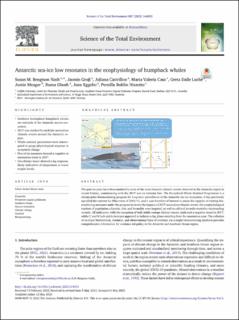| dc.contributor.author | Nash, Susan M. Bengtson | |
| dc.contributor.author | Groß, Jasmin | |
| dc.contributor.author | Castrillon, Juliana | |
| dc.contributor.author | Casa, Maria Valeria | |
| dc.contributor.author | Luche, Greta Dalle | |
| dc.contributor.author | Meager, Justin James | |
| dc.contributor.author | Ghosh, Ruma | |
| dc.contributor.author | Eggebo, June | |
| dc.contributor.author | Bohlin-Nizzetto, Pernilla | |
| dc.date.accessioned | 2023-05-24T13:26:13Z | |
| dc.date.available | 2023-05-24T13:26:13Z | |
| dc.date.created | 2023-05-19T10:11:02Z | |
| dc.date.issued | 2023 | |
| dc.identifier.citation | Science of the Total Environment. 2023, 887, 164053. | en_US |
| dc.identifier.issn | 0048-9697 | |
| dc.identifier.uri | https://hdl.handle.net/11250/3068858 | |
| dc.description.abstract | The past six years have been marked by some of the most dramatic climatic events observed in the Antarctic region in recent history, commencing with the 2017 sea-ice extreme low. The Humpback Whale Sentinel Programme is a circum-polar biomonitoring program for long term surveillance of the Antarctic sea-ice ecosystem. It has previously signalled the extreme La Niña event of 2010/11, and it was therefore of interest to assess the capacity of existing biomonitoring measures under the program to detect the impacts of 2017 anomalous climatic events. Six ecophysiological markers of population adiposity, diet, and fecundity were targeted, as well as calf and juvenile mortality via stranding records. All indicators, with the exception of bulk stable isotope dietary tracers, indicated a negative trend in 2017, whilst C and N bulk stable isotopes appeared to indicate a lag phase resulting from the anomalous year. The collation of multiple biochemical, chemical, and observational lines of evidence via a single biomonitoring platform provides comprehensive information for evidence-led policy in the Antarctic and Southern Ocean region. | en_US |
| dc.language.iso | eng | en_US |
| dc.rights | Navngivelse-Ikkekommersiell 4.0 Internasjonal | * |
| dc.rights.uri | http://creativecommons.org/licenses/by-nc/4.0/deed.no | * |
| dc.title | Antarctic sea-ice low resonates in the ecophysiology of humpback whales | en_US |
| dc.title.alternative | Antarctic sea-ice low resonates in the ecophysiology of humpback whales | en_US |
| dc.type | Peer reviewed | en_US |
| dc.type | Journal article | en_US |
| dc.description.version | publishedVersion | en_US |
| dc.rights.holder | © 2023 The Authors. Published by Elsevier B.V. | en_US |
| dc.source.pagenumber | 9 | en_US |
| dc.source.volume | 887 | en_US |
| dc.source.journal | Science of the Total Environment | en_US |
| dc.identifier.doi | 10.1016/j.scitotenv.2023.164053 | |
| dc.identifier.cristin | 2148060 | |
| dc.source.articlenumber | 164053 | en_US |
| cristin.ispublished | true | |
| cristin.fulltext | original | |
| cristin.qualitycode | 2 | |

